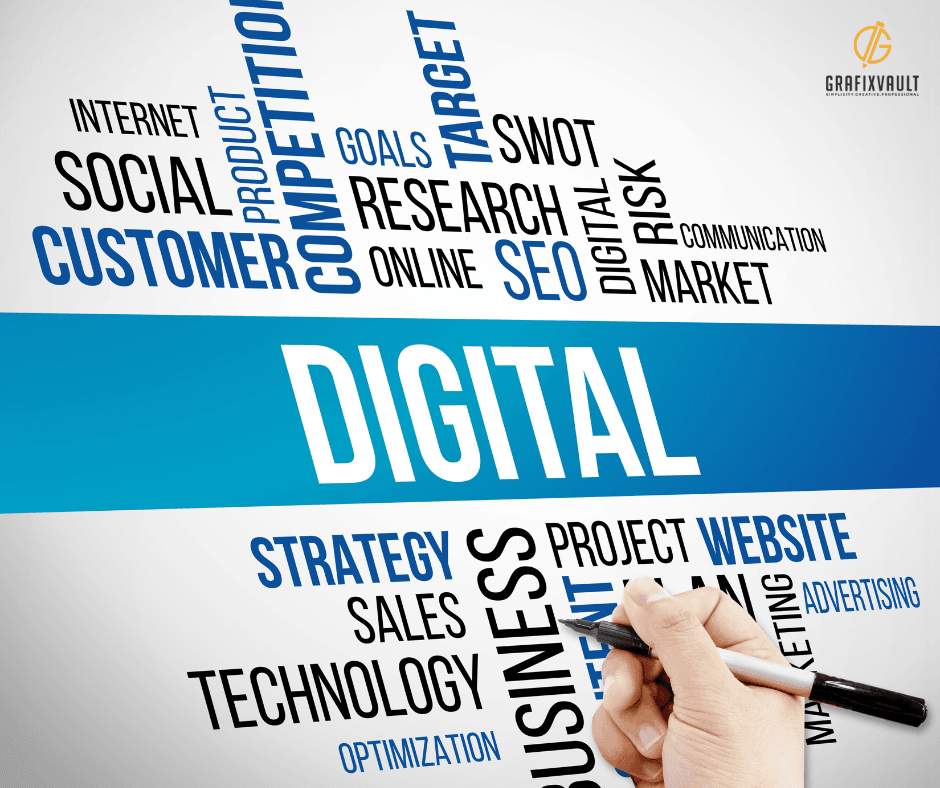Unleashing the Power of Digital Marketing: How to Grow Your Business Online
In today’s digital age, the potential for business growth knows no bounds. With the ever-expanding reach of the internet and the increasing number of online platforms, businesses have an unprecedented opportunity to connect with their target audience and drive growth like never before. Digital marketing has become the key to unlocking this potential, allowing businesses to reach new customers, build brand awareness, and drive sales. But with so many strategies, channels, and tactics available, it can be overwhelming to know where to start.
Fear not! In this guide, we will delve into the world of digital marketing, exploring the essential strategies and techniques that will help you harness the power of the online landscape and take your business to new heights. From search engine optimization (SEO) to social media marketing, and content creation to email campaigns, we will equip you with the knowledge and skills needed to navigate the digital marketing landscape and grow your business online. Let’s dive in and unleash the power of digital marketing together!
Understanding Digital Marketing and Its Importance
Digital marketing is the use of digital channels and tools to promote products or services, engage with customers, and drive business growth. It encompasses various strategies and tactics, all geared towards reaching and connecting with the target audience in the digital space. Understanding the importance of digital marketing is crucial for businesses of all sizes, as it provides the means to expand reach, increase brand visibility, and generate leads.
One of the key benefits of digital marketing is its ability to reach a global audience. Unlike traditional marketing methods, which are often limited to a specific geographic area, digital marketing allows businesses to connect with potential customers worldwide. This opens up new markets and growth opportunities, enabling businesses to expand their reach and tap into previously untapped markets.
Digital marketing also offers a level of personalization and targeting that is unmatched by traditional marketing. With the help of data analytics and tools, businesses can gain insights into customer behavior, preferences, and demographics. This allows for the creation of targeted campaigns that resonate with the audience, increasing the chances of engagement and conversion.
In addition to reach and personalization, digital marketing provides businesses with a cost-effective way to promote their products or services. Compared to traditional marketing methods such as print or TV advertising, digital marketing campaigns can be executed at a fraction of the cost. This makes it an ideal option for businesses with limited budgets, as it allows them to achieve maximum results with minimal investment.
Key Components of a Successful Digital Marketing Strategy
To harness the power of digital marketing and grow your business online, it is essential to have a well-defined strategy in place. A successful digital marketing strategy should incorporate various components that work together to achieve the desired goals. Here are some key components to consider:
1. The Power of Search Engine Optimization (SEO)
Search engine optimization (SEO) is the practice of optimizing a website to rank higher in search engine results pages (SERPs). When done effectively, SEO can drive organic traffic to your website, increase visibility, and improve brand credibility. To optimize your website for search engines, you need to focus on factors such as keyword research, on-page optimization, technical SEO, and link building.
Keyword research involves identifying the keywords and phrases that your target audience is using to search for products or services similar to yours. By incorporating these keywords strategically into your website content, meta tags, and headings, you can improve your chances of ranking higher in search results.
On-page optimization refers to optimizing individual web pages to make them more search engine friendly. This includes optimizing the page title, meta description, URL structure, and content.
Technical SEO involves optimizing the technical aspects of your website, such as site speed, mobile-friendliness, and crawlability. A well-optimized website improves user experience and helps search engines understand and index your content more effectively.
Link building is the process of acquiring high-quality backlinks from other websites. Backlinks are a crucial ranking factor, as they indicate to search engines that your website is trustworthy and authoritative. Building a strong backlink profile can significantly improve your website’s visibility in search results.
2. Harnessing the Potential of Social Media Marketing
Social media has become an integral part of our daily lives, and businesses can leverage its power to reach and engage with their target audience. Social media marketing involves creating and sharing content on social media platforms to promote your brand, drive website traffic, and generate leads.
The first step in harnessing the potential of social media marketing is to identify the platforms that are most relevant to your target audience. Each social media platform has its own unique demographics and user base, so it’s essential to choose the platforms where your target audience is most active.
Once you have identified the platforms, you need to create a social media content strategy. This involves determining the type of content you will create, the frequency of posting, and the tone and voice of your brand. Your content should be tailored to the platform and resonate with your target audience.
Engagement is key in social media marketing. It’s not enough to simply post content; you need to actively engage with your audience. Respond to comments, answer questions, and participate in relevant conversations. This helps build brand trust and loyalty.
Social media advertising is another powerful tool in your digital marketing arsenal. Platforms like Facebook, Instagram, and LinkedIn offer highly targeted advertising options, allowing you to reach specific demographics and interests. Paid social media ads can help increase brand visibility, drive website traffic, and generate leads.
3. Creating Engaging and Shareable Content
Content creation is at the heart of digital marketing. Compelling and valuable content helps attract and engage the target audience, build brand authority, and drive organic traffic to your website. To create engaging and shareable content, consider the following:
Identify your target audience and understand their needs and pain points. Your content should address these needs and provide solutions or valuable insights.
Focus on quality over quantity. Creating high-quality content that provides value to your audience will have a greater impact than producing a large volume of mediocre content.
Diversify your content formats. Experiment with different types of content such as blog posts, videos, infographics, podcasts, and ebooks. Different formats resonate with different audiences, so it’s important to cater to various preferences.
Optimize your content for search engines. Incorporate relevant keywords naturally into your content and ensure that it is well-structured and easy to read.
Promote your content through various channels. Share your content on social media platforms, include it in your email newsletters, and reach out to industry influencers for potential collaborations or guest posting opportunities.
Encourage social sharing. Include social sharing buttons on your website and make it easy for readers to share your content with their networks.
By creating engaging and shareable content, you can attract and retain a loyal audience, increase brand visibility, and drive organic traffic to your website.
Leveraging Email Marketing for Business Growth
Email marketing is a highly effective digital marketing strategy that allows businesses to communicate directly with their target audience. It involves sending targeted emails to subscribers who have opted in to receive updates, promotions, or other relevant content. Here are some key tips for leveraging email marketing for business growth:
Build a quality email list. Focus on attracting subscribers who are genuinely interested in your products or services. Offer valuable incentives, such as exclusive content or discounts, in exchange for email sign-ups.
Segment your email list. Break down your email list into smaller segments based on demographics, interests, or purchasing behavior. This allows you to personalize your email content and increase relevance.
Create compelling email content. Your emails should provide value to the recipient, whether it’s informative articles, special offers, or personalized recommendations. Use catchy subject lines and engaging visuals to grab attention.
Automate your email campaigns. Use email marketing automation tools to streamline your campaigns and send targeted emails based on triggers or customer behavior. This saves time and ensures that your emails are sent at the right time.
Measure and analyze your email marketing efforts. Track key metrics such as open rates, click-through rates, and conversions to evaluate the success of your email campaigns. Use this data to optimize your future campaigns and improve results.
Email marketing allows businesses to nurture leads, build customer loyalty, and drive repeat business. By leveraging the power of email, you can stay top of mind with your audience and drive business growth.
The Role of Paid Advertising in Digital Marketing
While organic strategies such as SEO and social media marketing are essential for long-term success, paid advertising can provide an immediate boost to your digital marketing efforts. Paid advertising involves paying for ad placements on search engines, social media platforms, or other websites. Here are some popular paid advertising options to consider:
Tracking and Measuring Your Digital Marketing Efforts
Tracking and measuring your digital marketing efforts is essential to understand what’s working and what needs improvement. By analyzing key metrics and data, you can optimize your strategies and tactics for better results. Here are some key metrics to track:
Website traffic: Monitor the number of visitors to your website, as well as the sources of traffic (organic, social, referral, etc.). This helps you understand which channels are driving the most traffic and where to focus your efforts.
Conversion rates: Track the percentage of visitors who take a desired action on your website, such as making a purchase, filling out a form, or subscribing to your newsletter. This helps you evaluate the effectiveness of your website and landing pages.
Email marketing metrics: Track open rates, click-through rates, and conversions for your email campaigns. This helps you evaluate the effectiveness of your email marketing efforts and make improvements.
Social media metrics: Monitor metrics such as reach, engagement, and follower growth on social media platforms. This helps you understand which content resonates with your audience and which platforms are performing well.
Search engine advertising: Platforms like Google Ads allow businesses to bid on keywords and display ads in search engine results. This can help increase visibility and drive targeted traffic to your website.
Social media advertising: Platforms like Facebook Ads, Instagram Ads, and LinkedIn Ads offer highly targeted advertising options. You can target specific demographics, interests, or behaviors, and reach a large audience.
Display advertising: Display ads are banner ads that appear on websites, often in the form of images or videos. Display advertising allows you to reach a wide audience and increase brand visibility.
Paid advertising can be a powerful tool to increase brand visibility, drive website traffic, and generate leads.
Tools and Resources for Effective Digital Marketing
The world of digital marketing is constantly evolving, and staying up to date with the latest trends, tools, and resources is essential for success. Here are some popular tools and resources that can help you effectively navigate the digital marketing landscape:
Google Analytics: A free web analytics tool that provides valuable insights into your website traffic, user behavior, and conversions. It helps you track key metrics and make data-driven decisions.
Keyword research tools: Tools like Google Keyword Planner, SEMrush, and Moz Keyword Explorer can help you identify relevant keywords and track keyword rankings.
Content management systems (CMS): Platforms like WordPress, Joomla, and Drupal make it easy to create and manage your website content. They offer various plugins and themes to enhance your website’s functionality and design.
Social media management tools: Tools like Hootsuite, Buffer, and Sprout Social allow you to schedule and manage your social media content from a single dashboard. They also provide analytics and reporting features to track your social media performance.
Email marketing automation tools: Platforms like Mailchimp, ConvertKit, and HubSpot automate your email campaigns, segment your email list, and provide analytics to measure the success of your email marketing efforts.
Paid advertising platforms: Platforms like Google Ads, Facebook Ads Manager, and LinkedIn Ads offer comprehensive tools to create, manage, and optimize your paid advertising campaigns.
Industry blogs and publications: Stay updated with the latest digital marketing trends and strategies by following industry blogs and publications such as Moz, Search Engine Journal, and Social Media Examiner.
Online courses and certifications: Platforms like Coursera, Udemy, and HubSpot Academy offer a wide range of digital marketing courses and certifications to enhance your skills and knowledge.
Conclusion: Taking Your Business to New Heights with Digital Marketing
Digital marketing offers businesses a world of opportunities to connect with their target audience, drive growth, and take their business to new heights. By understanding the importance of digital marketing, implementing key strategies, and leveraging the right tools and resources, you can unlock the power of the online landscape and achieve your business goals. From search engine optimization (SEO) to social media marketing, content creation to email campaigns, each component of digital marketing plays a crucial role in your overall success. So, dive in, experiment, and adapt to the ever-changing digital marketing landscape. Unleash the power of digital marketing and watch your business thrive in the online world!







Leave A Comment